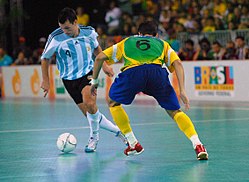
Futsal helped also identified with various other names. The term "Futsal" is the international term, derived from the Spanish or Portuguese, football and sala.
Futsal popularized in Montevideo, Uruguay in 1930, by Juan Carlos Ceriani. The uniqueness of futsal attention throughout South America, particularly in Brazil. Skills developed in this game can be seen in the style of the world famous Brazilian players are shown outdoors on a regular sized field. Pele, the famous star of Brazil, for example, developed his talents in futsal. While Brazil continues to be the center of world futsal, the game is now played under the auspices of the Fédération Internationale de Football Association over the world, from Europe to Central America and North America as well as Africa, Asia, and Oceania.
The first international match was held in 1965, Paraguay won the first South American Cup. Six subsequent seizure of the South American Cup held until 1979, and wiped out all the carpet champions Brazil. Brazil to continue his dominance by winning the first Pan American Cup in 1980 and won again the next year struggle for pd 1984.
The first Futsal World Championship was held on help FIFUSA (before its members joined FIFA in 1989) in Sao Paulo, Brazil, in 1982, ended in Brazil in the first position. Brazil repeated the victory in the second World Championships in Spain in 1985, but suffered a defeat of Paraguay in the third World Championship in 1988 in Australia.
Futsal international match was held in the U.S. in December 1985, at Sonoma State University in Rohnert Park, California. Futsal The Rule of the Game Futsal popularized in Montevideo, Uruguay in 1930, by Juan Carlos Ceriani. The uniqueness of futsal attention throughout South America, particularly in Brazil. Skills developed in this game can be seen in the style of the world famous Brazilian players are shown outdoors on a regular sized field. Pele, the famous star of Brazil, for example, developed his talents in futsal. While Brazil continues to be the center of world futsal, the game is now played under the auspices of the Fédération Internationale de Football Association over the world, from Europe to Central America and North America as well as Africa, Asia, and Oceania.
The first international match was held in 1965, Paraguay won the first South American Cup. Six subsequent seizure of the South American Cup held until 1979, and wiped out all the carpet champions Brazil. Brazil to continue his dominance by winning the first Pan American Cup in 1980 and won again the next year struggle for pd 1984.
The first Futsal World Championship was held on help FIFUSA (before its members joined FIFA in 1989) in Sao Paulo, Brazil, in 1982, ended in Brazil in the first position. Brazil repeated the victory in the second World Championships in Spain in 1985, but suffered a defeat of Paraguay in the third World Championship in 1988 in Australia.
Futsal international match was held in the U.S. in December 1985, at Sonoma State University in Rohnert Park, California. Futsal The Rule of the Game
Extensive field
Size: 25-43 m length x width of 15-25 m
The boundary line: the line width of 8 cm, which touch on the side line, goal line at the ends, and transverse center of the field, 3 m center circle, and no barriers or boards
Penalty area: arc measuring 6 m from each goalpost
Penalty: 6 m from the midpoint of the goal line
The second penalty: 10 m from the midpoint of the goal line
Zone change: area 5 m (5 m from the halfway line) on the grandstand side of the throwing
Hurdles: 2 m high x 3 m wide
Surface area throwing: smooth, flat, and not abrasive
[Edit] Ball
Size: 4
Circumference: 62-64 cm
Weight: 0.4 to 0.44 kg
Bounce: 55-65 cm on first bounce
Material: leather or other suitable material (ie non-hazardous materials)
The number of players (per team)
Maximum number of players to start a match: 5, one goalie
Minimum number of players to end the game: 2 (not including injuries)
Maximum Number of reserve players: 7
Number of referees: 2
Number linesman: 0
Limit the number of substitutions: unlimited
Methods change: "change of drift" (all players except the goalkeeper may enter and leave the field at any time; turnover goalkeeper can only be done if the ball is not being played, and with the approval of the referee)
And the referee should not step on the field arena, just outside the line of the field may be, unless there are violations that have entered the field
Long game
Old Normal: 2x20 minutes
Old istiharat: 10 minutes
Old extension: 2x5 minutes (if the result is still a draw after normal time 2x20 minutes)
There are penalties (maximum of 5 goals) if the number of goals both teams finish the series in overtime
Time-out: 1 per team per round; none in extra time
Turn round time: up to 10 minutes



0 komentar:
Posting Komentar